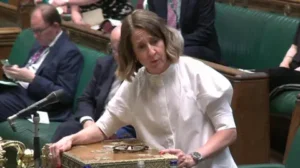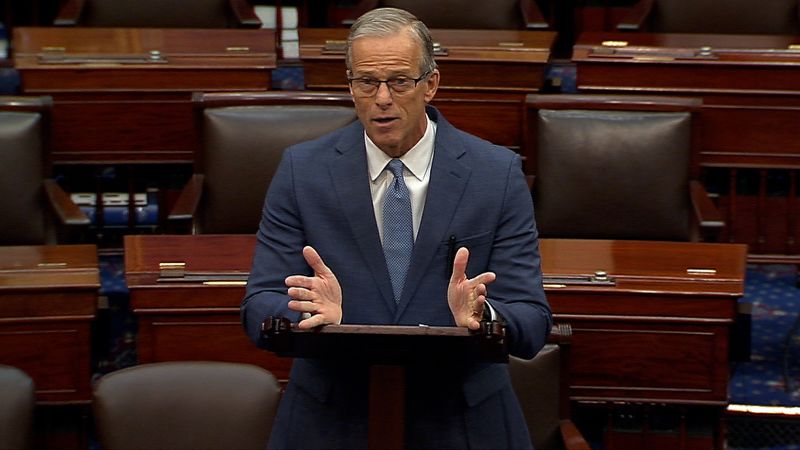The Senate has officially embarked on an extensive voting session regarding President Donald Trump’s comprehensive domestic policy bill, following a weekend filled with discussions and negotiations. This significant legislation has stirred considerable attention and debate among lawmakers, each party positioning itself in a manner that reflects their political ideologies and strategic interests.
Senate Majority Leader John Thune addressed reporters on Monday morning, optimistically stating, “hopefully we’ll know soon enough” if the Republicans have sufficient votes to advance the bill. He also acknowledged the potential duration of the voting process, signaling both the complexity and importance of the legislation they are grappling with.
The session is characterized by a phenomenon known as “vote-a-rama,” a lengthy and often chaotic series of votes aimed at amendments related to the bill. This format allows Republicans to make last-minute changes while simultaneously enabling Democrats to highlight vulnerable areas in the GOP’s proposal, ultimately pushing their colleagues into the limelight on politically sensitive issues. This dynamic could serve as fodder for future campaign advertisements, illustrating how votes on this legislation may impact the political landscape moving forward.
Trump’s substantial policy package, which amounts to trillions of dollars, proposes to reduce federal taxes while increasing funding for the Pentagon and agencies focused on border security. At the same time, it suggests cuts to government safety-net programs, including Medicaid, which has raised alarm among Democrats and advocacy groups concerned with the impacts on vulnerable populations.
In light of this, Senate Democrats are likely to concentrate on the ramifications of cuts to Medicaid and other essential programs as they criticize the president’s agenda. The marathon voting session commenced after the Democrats employed a strategic delay tactic over the weekend, compelling clerks to read the entire bill aloud for over a dozen hours, setting the stage for a lengthy debate.
The Senate resumed its discussions early Monday, convening at 9 a.m. ET to examine potential amendments to the bill. A crucial aspect of this process is adhering to a tight timeline, as the president has insisted that Congress deliver the finalized bill to his desk by the Fourth of July. However, should the Senate pass the bill, it would still need to be returned to the House for further deliberations, adding another layer of complexity to the process.
Republican senators are paying close attention to any modifications related to Medicaid within the bill. According to a Congressional Budget Office (CBO) analysis, the Senate’s version could potentially leave 11.8 million additional people without health coverage by 2034—more than the House’s projected increase of 10.9 million. This alarming statistic reflects the depth of the proposed cuts to Medicaid, which currently supports over 71 million low-income Americans, including children and the elderly.
Both legislative chambers are advocating for substantial spending reductions in Medicaid, but the Senate’s version entails even deeper cuts than those suggested by the House. Specifically, the Senate bill aims to slash federal funding for Medicaid by approximately $930 billion over the next decade, a stark contrast to the House proposal which anticipates a reduction of about $800 billion.
For the first time in its 60-year history, the program would place work requirements on able-bodied adults ages 19–64 in order to maintain their benefits. The Senate version extends this requirement to parents of children aged 14 and older, in contrast to the House version that offers exemptions for the parents of dependent children.
Additionally, the Senate bill proposes to change the tax structure regarding healthcare providers, altering the cap on taxes that states impose to fund Medicaid while also raising provider reimbursement rates—although these changes would initially apply solely to the 40 states and the District of Columbia that have expanded their Medicaid programs.
The foremost vote on Monday centered around a procedural disagreement regarding the so-called current policy baseline. Republicans aim to utilize an alternative scoring method proposed by some party leaders, which would ostensibly understate the fiscal impact of the bill by not accounting for the costs associated with the lapsing 2017 tax provisions. In contrast, the CBO’s evaluation, based on traditional scoring methods, forecasted that the Senate bill could add roughly $3.3 trillion to the deficit over the next decade, underlining the financial implications of the expansive tax cuts included in the Senate’s approach.
Overall, the interactions and negotiations occurring within the Senate reveal the complex and multifaceted nature of crafting such significant legislation. Various fiscal implications, social welfare considerations, and partisan strategies are all at play as lawmakers navigate the arduous process of reforming domestic policies that affect millions of Americans.











